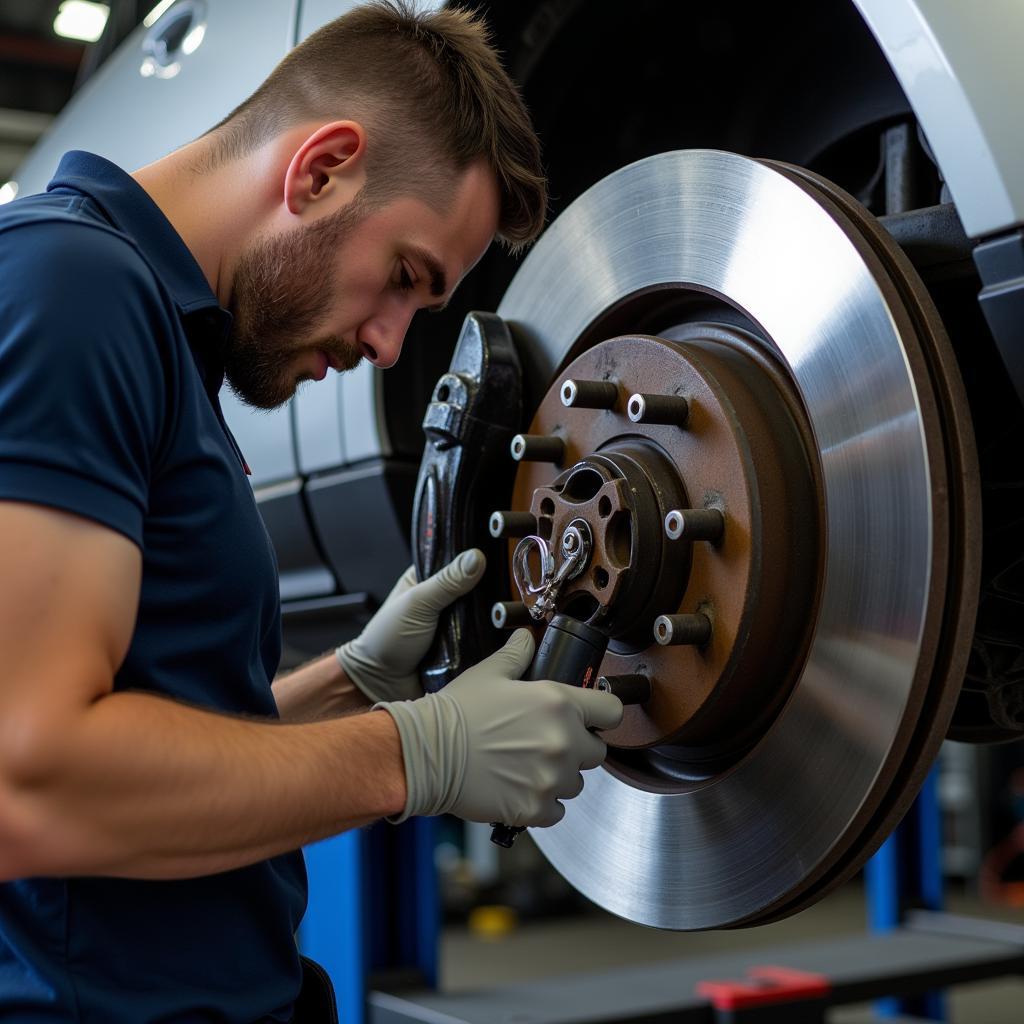The dreaded LR3 brake pad warning light – a sight no Land Rover owner wants to see. This little light can signal a minor inconvenience or a more serious issue with your braking system. Ignoring it can lead to costly repairs down the road. This article is your comprehensive guide to understanding, diagnosing, and addressing the LR3 brake pad warning light.
What Triggers the LR3 Brake Pad Warning Light?
Your LR3 is equipped with a sophisticated electronic system that constantly monitors vital components, including the brakes. The brake pad warning light is triggered by a sensor that measures the thickness of your brake pads. When the pads wear down to a certain point, the sensor sends a signal to the dashboard, illuminating the warning light.
However, several factors besides worn brake pads can trigger the warning light:
- Worn brake pad sensor: The sensor itself can wear out or get damaged, causing a false warning.
- Faulty wiring: Damaged or corroded wiring within the brake system can disrupt the signal from the sensor.
- Low brake fluid level: Brake fluid is essential for transferring hydraulic pressure, and a low fluid level often indicates a leak in the system.
- Issues with the ABS system: While less common, problems with the Anti-lock Braking System (ABS) can also trigger the brake pad warning light.
Diagnosing the LR3 Brake Pad Warning Light
When the warning light appears, it’s essential to diagnose the root cause before proceeding:
- Check your brake fluid level. Locate the brake fluid reservoir under the hood (refer to your owner’s manual for the exact location) and check the fluid level. If it’s low, there might be a leak in your brake system.
- Inspect your brake pads. If you’re comfortable with basic car maintenance, you can visually inspect the thickness of your brake pads through the spaces between the wheel spokes.
- Use an OBD-II Scanner. An OBD-II scanner can read the error codes stored in your LR3’s computer, providing valuable insights into the cause of the warning light.
 Mechanic Diagnosing LR3 Brake Issues
Mechanic Diagnosing LR3 Brake Issues
What to Do When the Light Comes On
The appropriate course of action depends on the diagnosis:
- Worn Brake Pads: If your brake pads are worn down, replace them immediately. Continuing to drive with worn pads can damage the rotors and compromise braking performance.
- Worn Sensor: Replace the brake pad sensor.
- Faulty Wiring or Low Brake Fluid: Address any wiring issues or leaks in the brake system and refill the brake fluid to the recommended level.
- ABS Issues: These issues can be complex and require specialized tools and expertise. It’s best to consult a qualified mechanic for diagnosis and repair.
The Importance of Timely Action
Ignoring the LR3 brake pad warning light can lead to:
- Reduced Braking Performance: Worn brake pads compromise your ability to stop safely, increasing the risk of accidents.
- Expensive Repairs: Driving with worn pads can damage the rotors, leading to more expensive repairs.
- Safety Risks: A malfunctioning brake system puts you and other drivers at risk.
Remote Diagnostics and Software Solutions for LR3 Brake Issues
In today’s digital age, advancements in automotive technology have paved the way for remote diagnostics and software solutions, offering efficient and convenient ways to address certain LR3 brake issues.
-
Remote Diagnostics: Qualified technicians can remotely access your LR3’s onboard computer system to retrieve diagnostic data, including error codes related to the brake system. This allows for faster and more accurate diagnosis, especially for issues beyond worn brake pads or sensors.
-
Software Updates and Programming: Occasionally, software glitches or outdated firmware in your LR3’s braking system can trigger warning lights or affect performance. Remote software updates and programming can effectively address these issues, often eliminating the need for a physical visit to a service center.
“Remote diagnostics and software solutions are transforming the automotive repair landscape,” says John Smith, Senior Automotive Engineer at CARDIAGTECH. “By leveraging these technologies, we can diagnose and resolve many LR3 brake issues remotely, saving our clients time and money.”
LR3 Brake Pad Warning: FAQs
Here are some frequently asked questions about the LR3 brake pad warning light:
1. How long can I drive with the brake pad warning light on?
It’s not advisable to drive with the warning light on. Get it diagnosed and addressed as soon as possible.
2. Can I replace the brake pads myself?
Replacing brake pads is a moderately difficult DIY task. If you’re comfortable with car maintenance, you can find tutorials online. However, it’s best to leave it to professionals if you’re unsure.
3. How often should I replace my LR3’s brake pads?
Brake pad lifespan varies greatly depending on driving conditions and habits. As a general rule, have your brakes inspected every 12,000 miles.
4. Is it safe to drive with a faulty ABS sensor?
While you can still brake with a faulty ABS sensor, your car won’t be able to prevent wheel lockup during hard braking.
5. Why is my brake pedal soft?
A soft brake pedal usually indicates a problem with the hydraulic system, such as low brake fluid or air in the lines.
Conclusion
The LR3 brake pad warning light is a crucial safety feature that should never be ignored. By understanding its causes, taking prompt action, and utilizing modern diagnostic tools and services, you can ensure optimal braking performance and keep your LR3 running safely and smoothly for miles to come.
